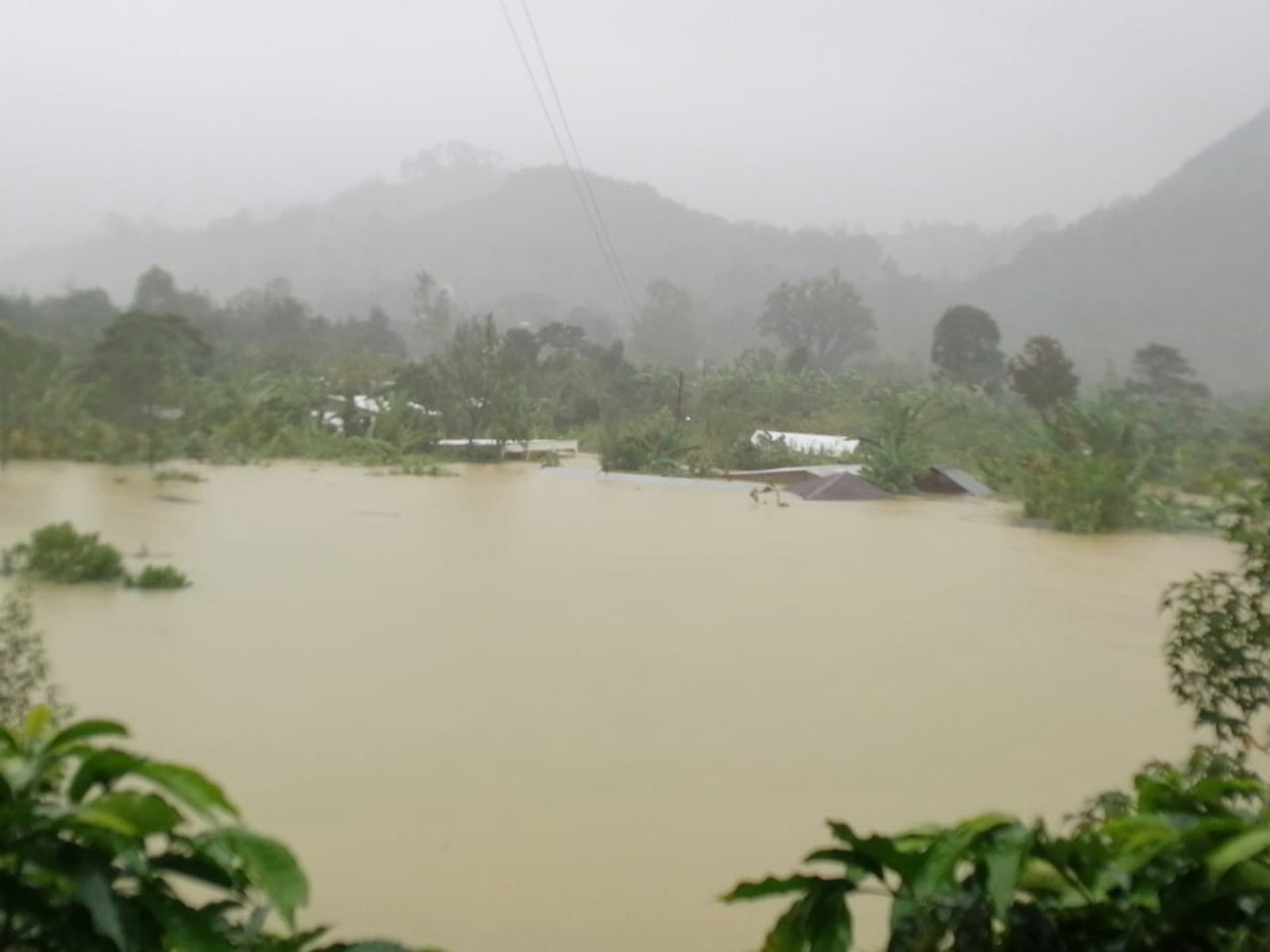We’ve been fortunate to work with author and teacher Deborah Chandler as a contributor for decades. Her work with Mayan weavers of Guatemala has always inspired us. When we learned about the devastating effects of the 2020 hurricanes on their communities, we asked her for information about how to help. —Editors
The people of the lowland jungle area of Guatemala have many everyday uses for natural fibers. Ropes and hammocks handspun from maguey (sisal), sleeping mats woven with shoreline grasses, baskets made from palm or pine needles, and shoes and hats crafted from tule.
In the jungle areas, many of the houses are built of cane, a stalk not unlike bamboo. Most of the time it is very hot, so no “mortar” of any kind is used, and the ventilation is welcome. Roofs may be either thatch, made of palm branches, or lamina, which is the corrugated metal that is used all over the country on all kinds of structures. One of the other values of those cane houses, for better or worse, is that rising water can enter and leave easily. Normal tropical rains are planned for, but hurricanes, such as Eta and Iota, are not. And so, our story begins.
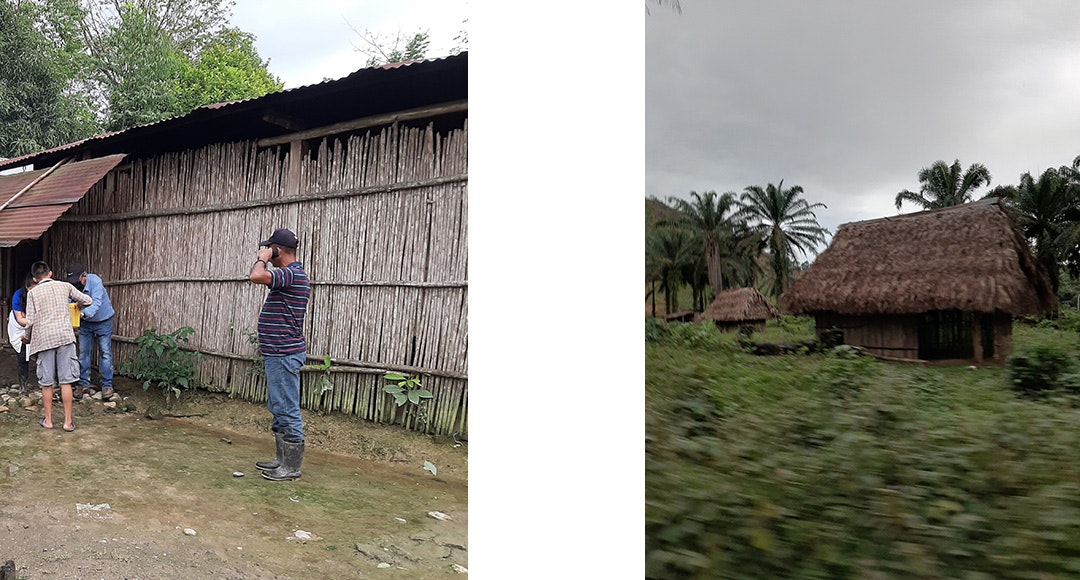
Left: Walls of cane. Right: roof made of palm branches and leaves.
Hurricanes Eta and Iota
In November 2020, Central America was hit hard by two major hurricanes within two weeks. Guatemala was inundated with more rain than it had seen at one time in years, and half the country was affected with many villages buried by mud or flooded over bedrock, which held the water there for weeks or even months.
The United Nations Office for the Coordination of Humanitarian Affairs put out this map of areas affected. The reddest are the areas hardest hit, but even more telling are the locations in blue, which note overflowing rivers and lakes, dozens of them. More than 300,000 acres, or 500 square miles, of crops were destroyed, and more than 200,000 people were affected. While some were momentarily inconvenienced, others lost everything.
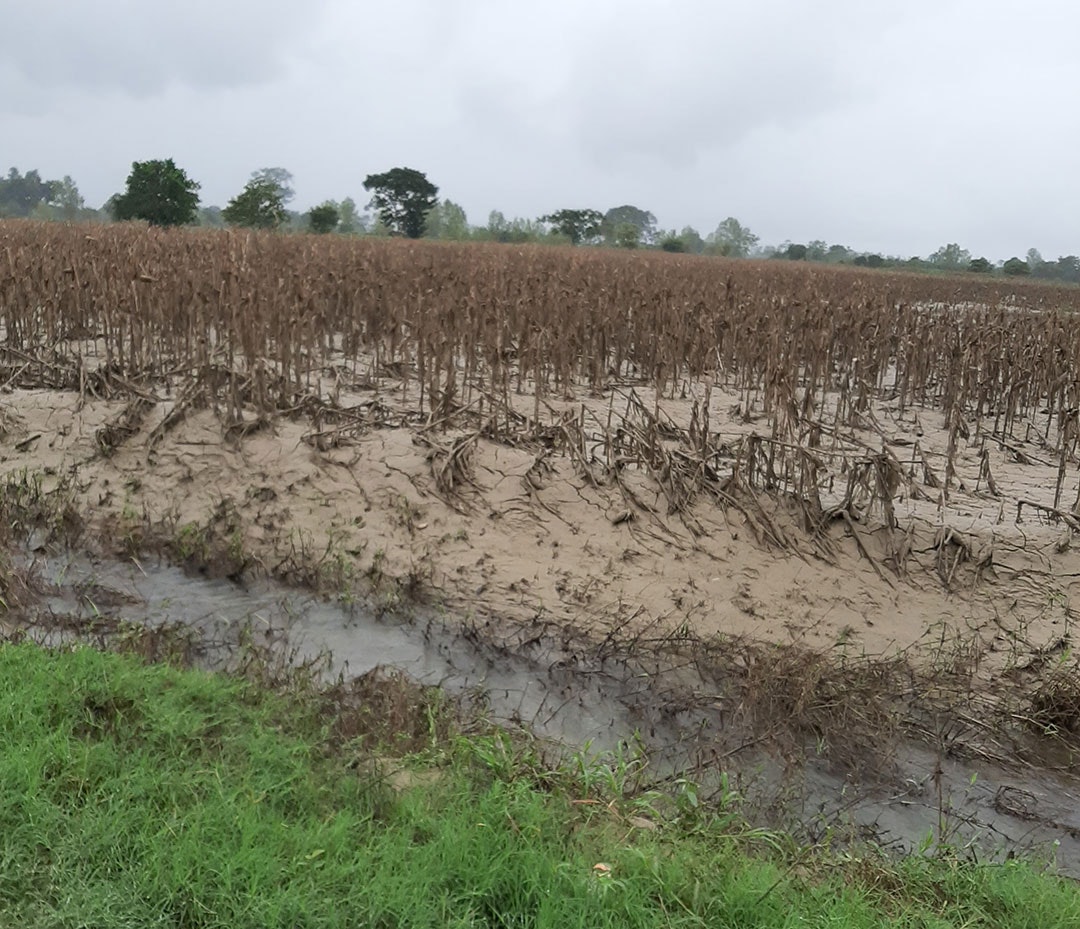
We passed miles of destroyed corn fields.
The Relief Efforts
My adopted Guatemalan family is always ready to help in dire situations, and they’re knowledgeable about how, having been through a few of these natural disasters themselves. The family includes Maritza, who is the Director of AMASURLI, which oversees water quality for Lake Izabal and its entire watershed. Thanks to her job, Maritza has colleagues and contacts, both government and private, throughout the area. Combine those two factors, and we have a strong setup for being useful.
Maritza started calling her contacts to find out who was worst off and who needed what, and the rest of us got busy finding money and buying food and hygiene supplies for people living in shelters of every description. Once food was more or less secured, we started working on longer-term help. Over the next couple of weeks and most of December, we bought supplies to help people dig out and set up house again. We purchased shovels; hoes; sheets of heavy black plastic, which could serve as walls or floors or ceilings; household items, such as pots and pans and dishes; cleaning supplies of all kinds; blankets (it is chilly there this time of year); water jugs; balls for the kids to play with; and since we were delivering just before Christmas, a Magdalena, which is a traditional Christmas cake, for each of the 112 families located in two communities. We took more than 4,000 items. As we made these deliveries, it was still raining every day.
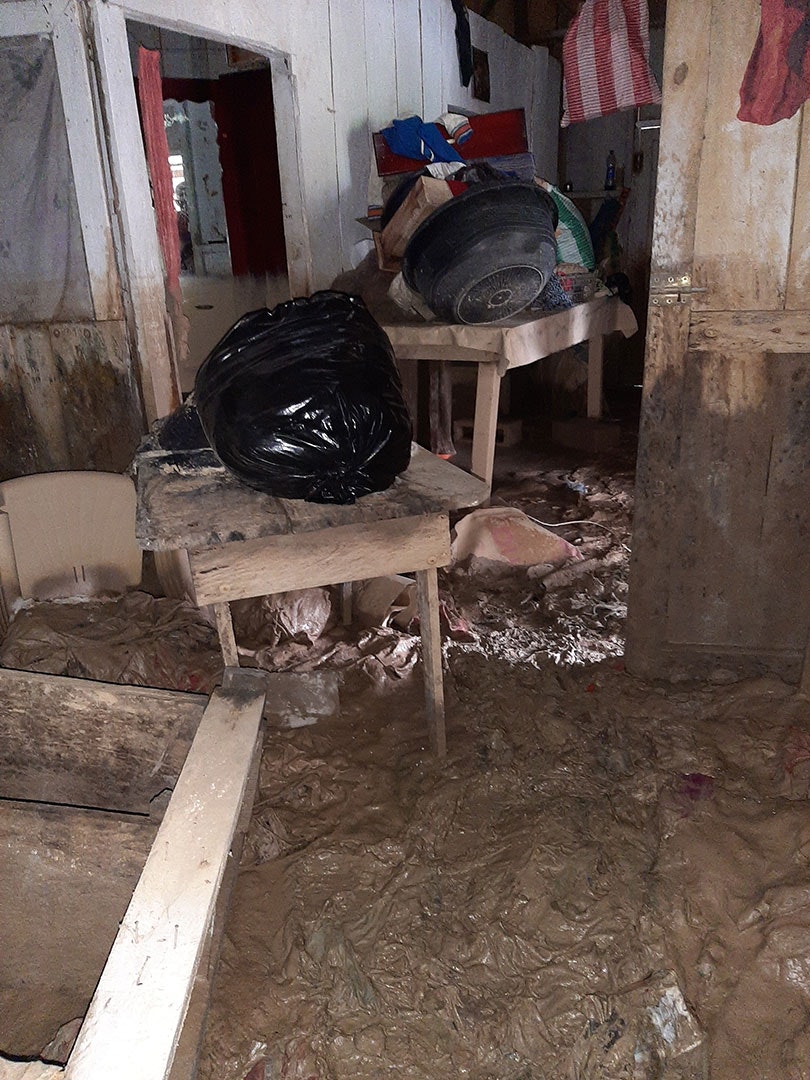
One mud-filled room in a home in Quineles. There is a concrete floor underneath.
Pombaaq is in the blue area southwest of Lake Izabal (white on the map above). It took us almost seven hours to get there, a distance of maybe 45 miles. We crossed two rivers, one by bridge, one by ferry, drove through large sections of mudflats with no living plants, and passed miles of now-useless cornfields. The primary employer of the area runs vast palm-oil plantations, which will survive. Mostly we saw mud, endless mud. Three of our four vehicles had four-wheel drive and still barely got through. Our large truck got so stuck that we had to push it out with human power, there being no other kind available.
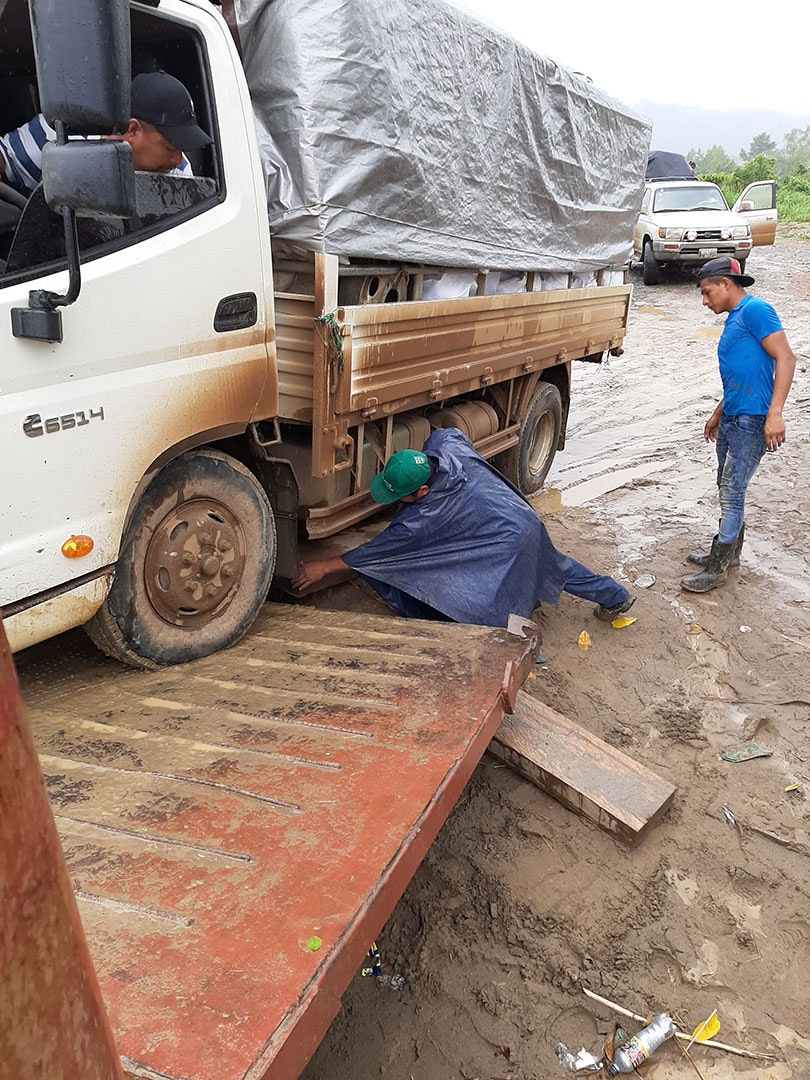
Getting the truck onto the ferry was no small feat.
All of this was possible thanks to donations from friends in the United States and Guatemala. What we did was a big effort, but tiny compared to the overall need. We have two more trips planned to other Maya Q’eqchi communities near Pombaaq. We are excited that the next time we will be taking rolls of fishing line, so the men of these fishing communities can make new nets and begin fishing in the river and the lake once again.
How to Help
Fortunately, there are a great many people working on a small scale, much as we are. Heidi McKinnon of Santa Fe, New Mexico, is working specifically with weavers’ groups in Alta Verapaz. To start, her efforts have been toward providing roofing materials. And she has a fund going that is dedicated to buying looms and yarns so the weavers can get started working again as soon as their homes are stable.
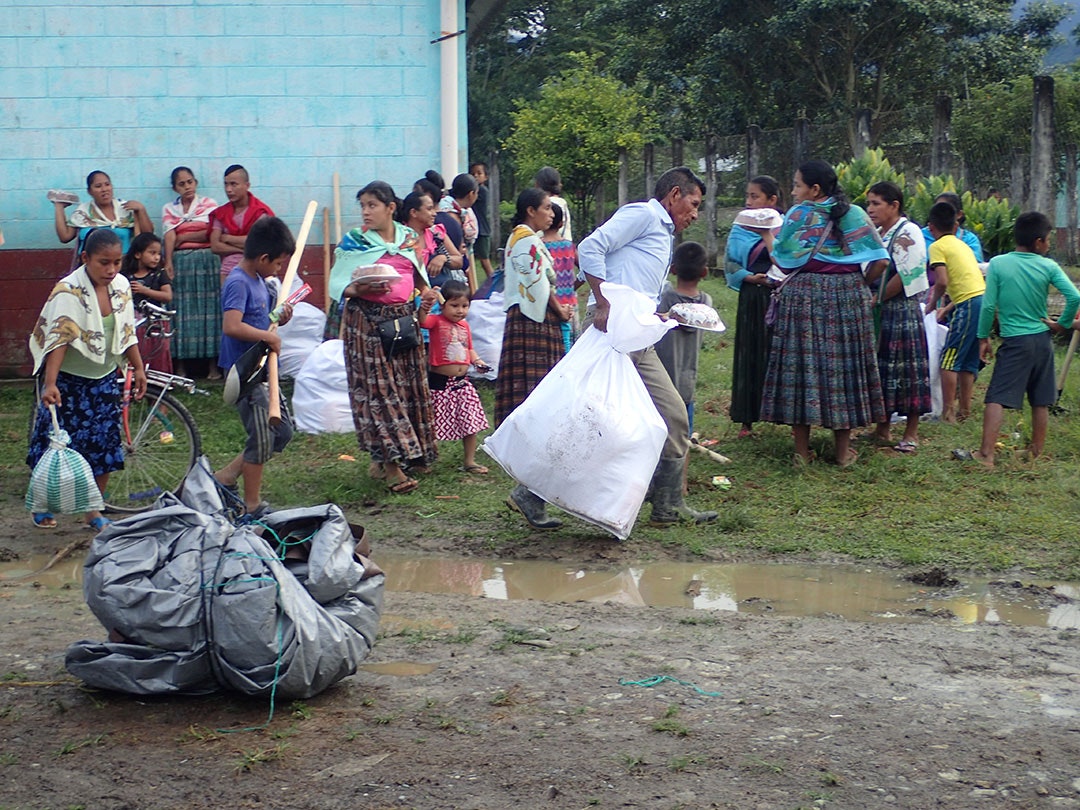
Some of the families of Pombaaq getting ready to slog home through the mud with their donated goods.
If you have been to the International Folk Art Market, in Santa Fe, you may have met Amalia Güe, the leader of the group of weavers Heidi is helping. Heidi’s program plans to invest $50 per weaver in materials, and they have pledged to help 60 weavers to start. If you want to support Heidi McKinnon’s efforts for the weavers of Samac, go to her GoFundMe page, Hurricane Eta Relief for Samac Cooperative.
Another good player in the relief-work area is Rotary. There are a number of Rotary Clubs in Guatemala, and they are working in many locations, including the hard-to-reach mountains of Huehuetenango and Nebaj in northern Quiche, an area famous for their textiles. You can see pictures of the Rotary’s deliveries on their Facebook page. The big advantage they have over us is their size. They have a much broader reach, and like all of us, they are putting all donations into aid, not administration. Esther Brol is the wonderful woman I have been corresponding with there, and if you want more information about their efforts, you can write to her in English or Spanish at [email protected].
The primary purpose of this post is to let you know what has happened and is happening in Guatemala, a story that affects a great many artisans. Second is to let you know how you can help if you feel so moved.
As I said above, our efforts are supported by donations as well, and if you want to help, we are happy to accept. Please write to me at [email protected] for details about how to donate.
I know that there are more worthy causes than any of us can respond to, so if financial help is not an option, we still welcome good thoughts, prayers, hopes, and spreading the word. Thank you for caring; that’s all we are really hoping for.
Deborah Chandler is the co-author of Traditional Weavers of Guatemala: Their Stories, Their Lives (Thrums Books, 2018).

